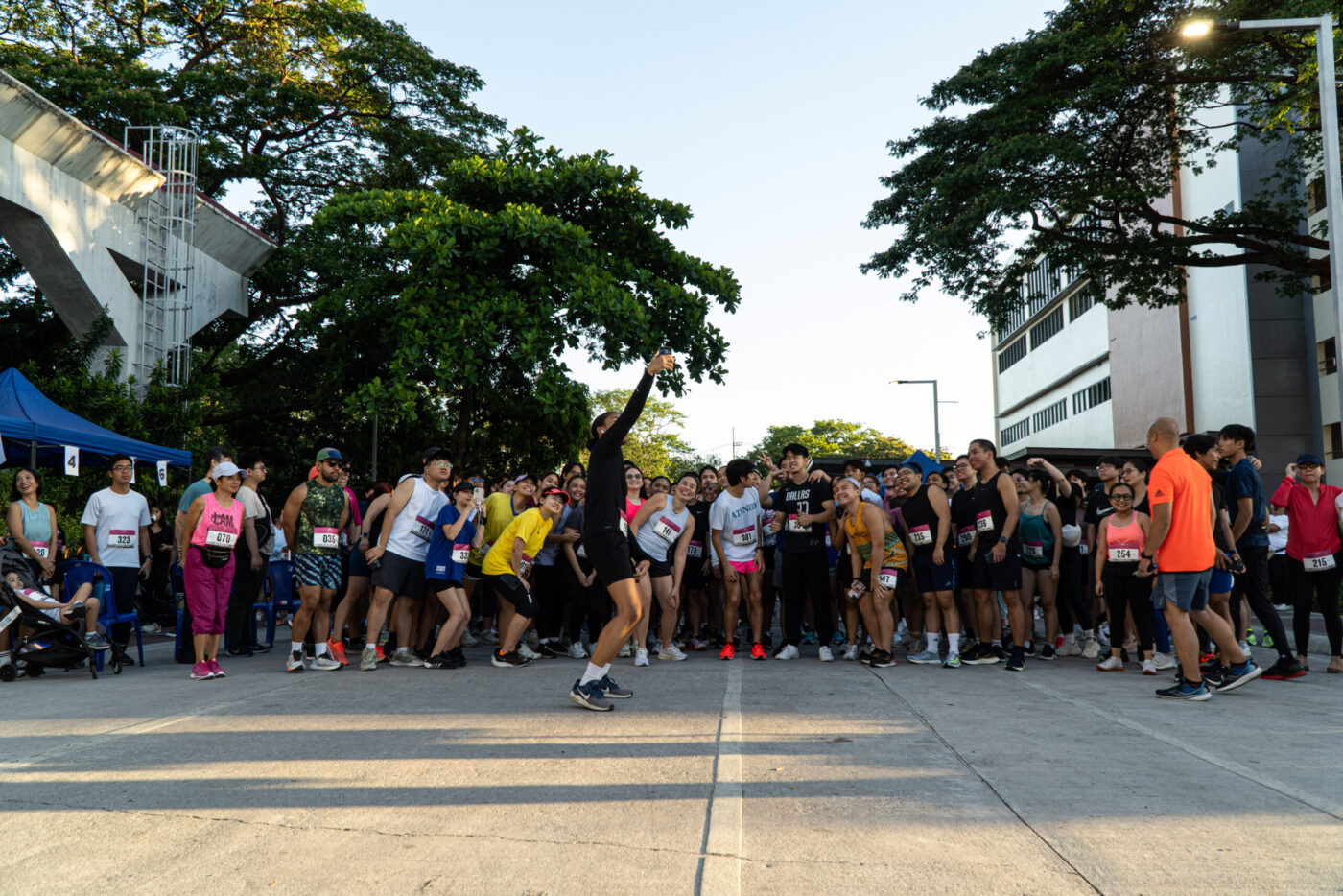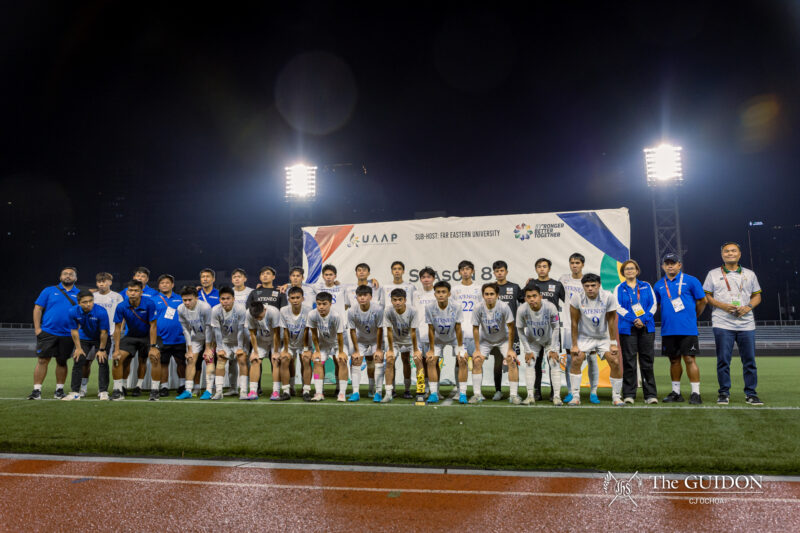RUNNING AND fitness have taken the Philippines by storm in recent years, as Filipinos discover new communities and fitness spaces within the car-centric environment of the urban Metro Manila. This nationwide trend is also making its mark in the Ateneo, where running and fitness activities have rapidly gained momentum.
As Filipinos seek healthier lifestyles amid the hustle and bustle of urban life, the streets and spaces of the Loyola Heights campus have become a hub for those looking to join the movement—with students, employees, and staff embracing running and cycling as their go-to fitness routine.
More than miles
Driving this surge in fitness running are social media applications such as TikTok and Strava, which allow runners to document their fitness journeys and share their progress with their co-runners and running clubs.
According to Office of Health Services Wellness Program Coordinator Dr. Cyrus Caballes, he noticed how the internet and social media have been key factors in this observed increased interest in fitness and active mobility.
“[T]here is really a growing trend inside Ateneo. You can see people after work, not only students but actually employees and staff. They also do exercises like jogging and biking,” he said.
While the surge in running may be recent, this fitness trend has its roots back to the 1970s, when fun runs in the country—particularly the inaugural Milo Marathon—attracted over 700 participants. Since then, the Philippines’ running scene has grown significantly, with more Filipinos lacing up and participating in marathon events.
“Sports and exercise are positive outlets to release the aggression and make the negative emotions, the mental exacerbations, and episodes more positive and constructive. So it’s another avenue for which patients, students or whoever, [can] channel those emotions,” Dr. Caballes added.
These physical and mental benefits of running are echoed by student runners Kristin Bernardino (2 BS MAC) and Derek Puertollano (2 BS BIO) who got into the hobby last year.
Puertollano is part of the Katipunan-based After Party Run Club who run around the Loyola Heights campus every Tuesday at 5 PM. On the other hand, Bernardino runs with close friends in the Loyola Heights campus two to three times a week.
Both runners shared that integrating running into their lifestyles has improved their time management and prioritization skills. They also describe running as an emotional release, allowing them to zone out and clear their minds with each stride.
Fostering a running culture
Among the tools Bernardino and Puertollano use for running is Strava, an application that lets users track their running, cycling, and other physical activities using GPS, while also enabling users to connect with friends and share their workouts. Strava’s rapid growth has also played a pivotal role in promoting running culture, encouraging more people to stay active and motivated.
According to their global data, Strava revealed that among their users, “Gen Z” runners aged 13 to 26 logged the fastest median run of 5.34 minutes per kilometer and ride pace of 20.8 kilometers per hour. Notably, they also tend to have the shortest run distance of only 5.9 km.
Moreover, Gen Z runners are also turning to Strava in building stronger social connections, with most users frequently sharing their statistics and comparing them with friends and family.
Sharing his personal experience, Puertollano said that he uses the app to check his pacing and cadence, as well as his running route, to compare these statistics to his previous runs. He explained that these figures motivate him to reach for greater distances and numbers.
Similarly, Bernardino also draws inspiration from the posts of her Strava friends who share their paces and runs. “It’s not peer pressure, but you get really inspired because of their posts. [Y]ou feel like you also want to try and achieve the same goals,” she says.
Furthermore, this sense of community support is mirrored in the rapid increase in the number of run clubs. For Puertollano, he has noticed how seasoned runners initiate conversations with fellow runners during runs, creating an environment of camaraderie.
As more runners seek this communal activity, run club founders find their circle to be continuously growing. 5 AM Run Club Co-founder Kahana Pe (BS MEC ‘20) shares that with the recent running boom, their Facebook group saw a surge in members earlier this year which has now ballooned to more than 20,000 members.
Pe himself started focusing on running this year, coinciding with the growth of the run club from his casual runs in 2023. “When people start to become runners, […] they often look for communities. […] I think that’s why run club[s] have really boomed,” he remarked.
Furthermore, he discussed how social media played a big role in the growth of running culture within the country, especially in a post-pandemic society where most people wanted to adapt to a healthier lifestyle. According to Pe, newcomers would often tell him that they discovered the club through their Instagram page where the group shares reels featuring a “club chant” at the end of each run.
Reclaiming spaces
Despite the growing culture, challenges still remain in making running and biking accessible to everyone, as the lack of infrastructure and green spaces in Metro Manila has forced pedestrians to narrow and non-existent sidewalks.
“[I] think what’s been hindering some people to run for the past years is that mahirap tumakbo in some areas. [F]or example, for me, here in Cubao, sobrang kitid ng mga places. Sobrang kitid ng mga sidewalks, sobrang kitid ng roads. Siksikan usually ang kotse,” Pe commented.
(I think what’s been hindering some people from running for the past years is the difficulty of running in some areas. For example, for me here in Cubao, places are too cramped, the streets and sidewalks are narrow, and roads are usually crowded with cars.)
However, recent efforts by Metro Manila mayors have made strides to address this problem by implementing car-free Sundays within cities like Pasig, Makati, Taguig, Manila, and Quezon City. These initiatives aim to transform major roads into more pedestrian-friendly spaces for bikes and people to do activities.
The growing abundance of both in-person and online communities signals a broader shift toward prioritizing health, social connection, and digital connectivity.
In a city still dominated by cars, initiatives like car-free Sundays offer a glimpse of more inclusive, pedestrian-friendly spaces for fitness enthusiasts. As more Filipinos lace up their running shoes, they not only commit to a healthier lifestyle but also contribute to a movement that champions mental well-being, social connection, and the reclamation of public spaces.
The path may still be crowded and narrow. However, like any good run, each step brings us closer to a more active and connected future.




